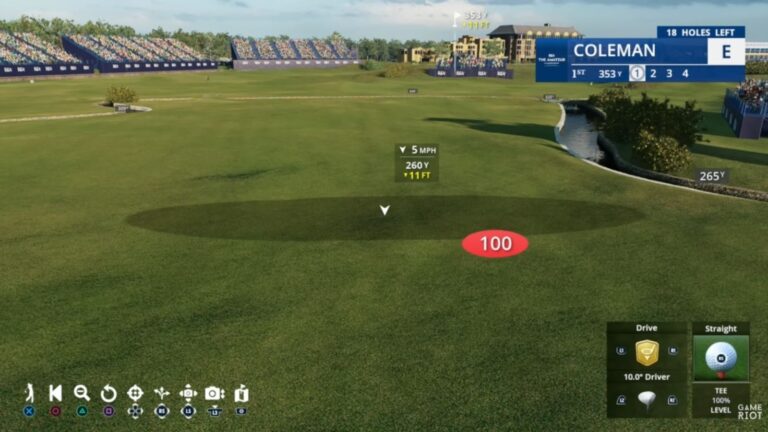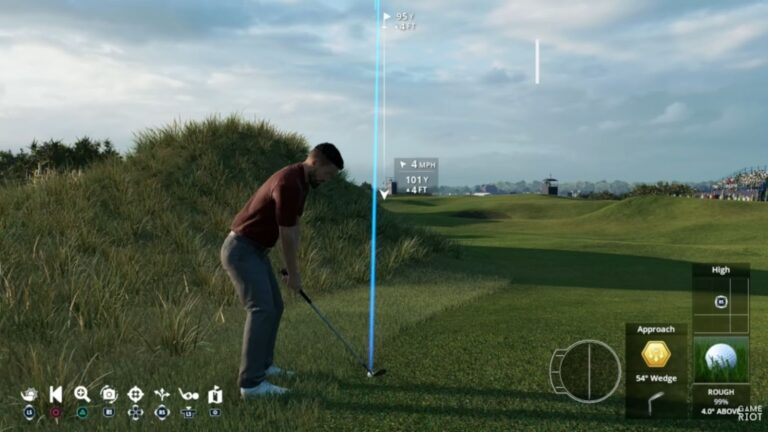Putting In EA Sports PGA Tour 2014
How To Putt In EA Sports PGA Tour 2014
To improve your putting skills in EA Sports PGA Tour 2014, understand the basics of putting. Learn the importance of putting in the game and the different types of putting shots. Additionally, follow some tips which can help you improve your putting skills.
The Importance of Putting in the Game
Putting is a vital aspect to excel in EA Sports PGA Tour 2014, as it can make or break the game. It requires precision and skills to putt the ball into the hole within strokes. One has to keep an eye on factors like terrain, wind speed, and distance, to name a few. Therefore mastering putting maneuvering can give a competitive edge among other players.
To become proficient at putting, you need to aim for the center of the hole and judge how much power you need for each shot. You can also use different types of putters with varying capabilities that suit your playing style. It is crucial to read the green facets by identifying slopes or any other disturbances that may affect your success rate while grabbing ample points.
In addition to these fundamentals of putting maneuvering, one must have a consistent rhythm and swing pattern that aligns perfectly with every attempt. The right posture and hand grip are also essential elements that contribute significantly to improve your putting capabilities.
Some suggestions that may come in handy while playing are practicing regularly under different conditions, reading tutorials online under credible sources like forums or gaming websites. It will guide you with tricks and tips from experienced players who mastered these skills through hard work and practice.
Puting is like a box of chocolates, you never know what you’re gonna get…unless you practice different types of shots in EA Sports PGA Tour 2014.
Types of Putting Shots
Putting Shots Variation in EA Sports PGA Tour 2014
Improve your putting skills by mastering different types of putting shots! Here is a table showing the various putting shot types, including their corresponding distances and recommended strengths.
| Type | Distance | Strength |
| Standard Putt | <=10ft | Medium |
| Up/Downhill Putt | >10ft uphill or downhill | High/Low (depends on direction) |
| Slow Greens Putt | <12 ft | barely tap it for precision. |
| Recovery Putting | text length |
To make your gameplay more immersive, EA Sports PGA Tour 2014 also includes unique features such as changing weather conditions and fluctuating green speeds that can affect your ball’s path.
Don’t miss out on these exciting putting shot variations – practice them all and improve your game today!
Putting is like a relationship, sometimes you just need to take things slow and steady to sink the hole.
Tips to Improve Your Putting Skills
If you want to sharpen your putting skills in EA Sports PGA Tour 2014, this section can guide you through it. Learn how to putt like a pro and boost your game performance with the tips shared here.
Follow these three simple steps to improve your putting skills:
- Choose the Right Putt
Choose an appropriate putt that suits the current situation. Consider the green slope, distance, and speed of the ball before making a decision. Select a putt that will give you a high percentage of meeting your objective. - Find Your Rhythm
Developing your putting rhythm is crucial for success. Find your unique tempo and maintain it throughout the game. Ensure that your backswing and downswing are consistent, adjust putter position accordingly when needed. - Practice Makes Perfect
Practicing regularly is key to refine your putting skills. Practice on different greens to encounter various slopes, speeds, distances and contours which can benefit you in-game.
In addition to these tips, it’s recommended to pay attention to factors such as wind speed, green conditions, and shot precision while playing.
It is believed that Golf stands on several foundations of cultural diversity traced as far back as ancient Greece in the 5th century BCE then further developed by Scotland where modern golf originated around 1457 AD. It’s fascinating how this discipline has evolved over time globally.
Putting is like a box of chocolates, you never know which technique you’ll get until you try them all in EA Sports PGA Tour 2014.
Mastering Different Putting Techniques
To master different putting techniques with Pendulum, Arc, and Straight Back and Through as solutions, learn to putt in EA Sports PGA Tour 2014. With the correct putting technique, you will be able to win more games and improve your overall performance. In this section, we will explore these three sub-sections of putting technique to guide you in improving your skills.
Pendulum Putting Technique
A putting technique that involves a pendulum swing is an efficient and consistent method of improving one’s golf game.
Here are three simple steps to mastering the technique:
- Set up with proper posture, aiming at the hole, and a grip on your putter that feels comfortable.
- Keep your arms and shoulders still while rocking your shoulders back and forth in a natural arc-like motion, like a pendulum.
- Follow through with your stroke in the same manner, keeping the putter face square at impact with the ball.
One key feature of this technique is maintaining your head position throughout the stroke to ensure optimal consistency.
Use this approach for several sessions to develop muscle memory and improve accuracy.
Ready to elevate your golf game? Try putting using a pendulum swing to gain success on the green. Why go straight when you can arc? Try the arc putting technique and watch your ball curve like a boss.
Arc Putting Technique
The Curved Putting Approach
For golfers aiming to improve their skills, the curved putting approach can be a game-changer. This technique involves positioning your putter along a curved path to direct the ball towards the hole.
Follow these six steps to perfect your curved putting technique:
- Align your body with your target and look at the clubface.
- Place the ball at the center of your stance.
- Curve your wrist inwards while straightening your backswing.
- Gently open up your wrist and start moving forward as you take your downswing.
- Guide the putterhead in an arc-shaped motion towards the hole while keeping a steady pace.
- Focus on following through with a slightly curved gesture as you hit the ball.
To strengthen this technique, take note of these unique details: visualize a straight line from the ball to your target and focus on rolling it across that line. Keep practicing with different positions and angles until you find what works best for you.
Additionally, try out some suggestions such as standing closer to the ball or using larger grips that extend beyond your palm. These techniques work by providing better grip on your equipment and increasing accuracy. Keep practicing until you develop consistency and comfort with this method.
Finally, a putting technique that doesn’t require a compass and protractor.
Straight Back and Through Putting Technique
One of the prominent putting techniques utilized by professional golfers is a “Putting style with straight back and through movement.” This technique involves swinging the putt club straight back from behind the ball to the targeted cup, maintaining a consistent angle throughout. It’s a particularly useful technique for players who struggle to align their putter correctly.
Here’s a step-by-step guide on how to master this technique:
- Begin by selecting an appropriate putter and adjust your grip accordingly.
- Stand square to the ball and place it in front of your dominant foot.
- Align yourself parallel to your target line, ensuring that your putter face is perpendicular
- Using controlled force, move the putter straight back in one continuous motion.
- Maintain the same clubface position across your putting stroke during the forward swing.
- Avoid any jerky movements as you strike the ball while keeping your body still
To perfect this technique in real scenarios, strive for consistency rather than aiming for perfection since even top professionals rarely achieve 100% accuracy. Use visual cues such as landmarks or checkers-point to track where you missed shots.
This technique usually works best if executed confidently, accurately measuring distance to avoid over or under-hitting balls. Rather than focusing primarily on speed/accuracy control from different distances covering 10-15 feet range can help strengthen this strategy.
Interestingly enough, Kevin Na once struggled severely with his putting before managing to develop a comprehensive method wherein he attained one of PGA Tours fastest strokes per round records, averaging just 1.363 putts per hole!
When it comes to choosing the right putter, remember that size does matter – but so does weight, grip, and how well it complements your unique style.
Choosing the Right Putter for Your Game
To improve your putting skills in EA Sports PGA Tour 2014, you need to select the perfect putter for your game. Choose the right putter from blade putters, mallet putters, and face-balanced putters based on your playing style and preference. Each sub-section has unique features that cater to different aspects of your putting game.
Blade Putters
Blade style golf putters are designed for players who prefer a more traditional and classic look. These putters feature a thin, straight blade-like head with minimal offset. The weighting is generally focused towards the heel of the club, making them ideal for players who have an arcing putting stroke.
| Pros | Cons |
| -Ideal for players with arcing putting strokes | -Less forgiving than mallet putters |
| -Provides precision and greater feedback to the player’s hands | -Smaller sweet spot compared to mallet putters |
| -Lighter head allows for greater feel and control on short putts |
One unique detail about Blade Putters is that they are often referred to as “Bullseye” or “Anser” style putters due to their resemblance of those historic designs. Additionally, many professional golfers still prefer this style of putter due to its classic appeal.
If you’re considering using a Blade Putter, here are some suggestions that may help improve your game:
- Use this style of putter if you prefer the traditional look.
- Consider your putting stroke when selecting a Blade Putter versus other styles.
- Practice before switching to this type of equipment as it may take some time to adjust.
Using a Blade Putter can be beneficial for certain types of players based on their preferences and skill level. By taking these tips into consideration, you may be able to make an informed decision on whether or not this type of club is right for you.
Why settle for a regular putter when you can upgrade to a mallet and have the added bonus of feeling like you’re wielding a miniature sledgehammer on the green?
Mallet Putters
Mallet-style putting instruments are designed to improve the overall alignment and accuracy of your putts. They have a distinctive shape, with a larger head that will help distribute weight more evenly across the clubface’s entire length, providing better control on contact.
To provide more clarity, we have created a table below that compares different manufacturers’ mallet putters:
| Manufacturer | Model | Weight (g) | Head Shape | Face Type |
| Odyssey Golf | O-Works Red 2-Ball Putter | 360 | Rounded Back Cavity Blade/Mallet Hybrid Head Shape | Microhinge Face Insert |
| TaylorMade Golf | Spider EX Putter | 324 g to 370 g | Mallet-Shaped Head with Large Perimeter Weighting System or Adjustable Sole Weights. | Pure Roll™ Insert |
It is important to consider not only the type of mallet putter you’re looking for but also what attributes matter most when selecting your instrument. The face insert and head shape should be carefully analyzed before choosing because they can help players achieve their desired speed and distance control.
A golf coach once shared how he had been struggling with his short game for years and how he eventually found success after switching to a mallet-style putter. He noted that his more traditional blade putters would always make contact towards the heel rather than the center of the clubface, which led to missed putts. The optimized alignment features present in many mallet-shaped designs greatly improved his accuracy around the greens, and as a result, he was able to shave several strokes off of his game.
Face-balanced putters are like the Switzerland of golf clubs – neutral, reliable, and can help you avoid getting into any putting wars.
Face-Balanced Putters
For golfers, finding the right putter for their game can make a big difference. When it comes to putters, one option to consider is those that are face-balanced. These types of putters have an even balance point, meaning that the face stays square to the target line throughout the putting stroke.
A table highlighting key specifications can help golfers understand what makes face-balanced putters unique. The table may feature columns such as Head Material, Club Length, Loft, Lie Angle, and Weight.
For example:
| Head Material | Club Length | Loft | Lie Angle | Weight |
| Milled Steel | 33”-35” | 3°-5° | 70°-78° | 340g |
| Milled Aluminum | 34”-36” | 2°-4° | 71°-79° | 312g |
It’s important to note that face-balanced putters may not be ideal for golfers with more arcing strokes because they don’t provide as much rotation around a player’s hands as other options do.
Interestingly, did you know that Jack Nicklaus popularized face-balanced putters in the early 1990s? He switched to them from blade-style putters and saw a significant improvement in his putting game. Since then, many other golfers have followed suit and embraced this style of putter for their own needs.
Putting on a green is like walking through a minefield, except the only explosions are in your ego.
Understanding the Putting Green
To master the putting mechanism in EA Sports PGA Tour 2014, understanding the putting green is essential. Reading the green, adjusting to slopes and breaks, and accounting for wind speed and direction are the key elements of this section. These sub-sections will guide you on how to putt like a pro and help you improve your game.
Reading the Green
Mastering the art of interpreting the slope and contours on a putting green is imperative for any golfer to sink their puts effectively. Analyzing the Green with keen attention helps golfers to predict how and where their ball will roll. By observing the Green’s Grass direction, Color, Speed, and Texture, they can gather clues about how it will influence the lines their ball follows towards its final destination.
Each golf course has its unique Putting Greens which require players to adjust their reading technique constantly. One way to do this is by observing where other balls lie on the green before taking a shot. Golfers must take note of slopes around holes and read the Green from different angles, considering elevations that might impact their shots during uphill or downhill putts.
It is crucial for every golfer to realize how Reading the Green can lead to considerable improvements in their gameplay if executed correctly. Ignoring these details would prevent them from seeing ways in which they could improve and potentially miss easy shots.
So, Fail not in sharpening your reading skills of Putt Greens as it holds real potential to be a game-changer! Careful on those slopes, unless you want your ball to go on a joyride without you.
Adjusting to Slopes and Breaks
Navigating the course’s uneven terrains can be a challenging aspect of golf. Adapting to inclines and turns in the ‘green’ is crucial to making accurate putts, and minimizing the total number of strokes needed.
Here are five tips for adjusting to slopes and breaks on the putting green:
- Assess the slope – use your eyes and feet to observe how steep or downwards facing each section is.
- Determine ball position – move the ball forward or back based on where you want it to exit.
- Choose an aiming point – select a spot farther from the hole than usual, taking into account how much sway will be caused by slope or breaks.
- Plan for power adjustment – swings should be lighter uphill and stronger downhill to keep shots on target.
- Trust your instincts- hitting more challenging greens can require more significant adjustments, but trust your judgment if you feel comfortable with a shot.
Reading the green carefully may provide extra insights into potential obstacles or imperfections that could affect precise targeting. These include both natural features such as wind patterns or water bodies near the course, as well as changes made by maintenance workers such as recent ground markings that factor into putter decisions.
It may take time and practice, but developing acumen while putting on sloping greens often improves your overall game accuracy. Using appropriate gear like spiked shoes will also contribute positively by increasing traction during play (especially in wet conditions)—lessening slide-offs even when performing tough strokes under extreme circumstances is now easier. Remember that patience should always accompany improvements; taking time to analyze each stroke holistically will give you greater control over every inch of turf!
Hope you brought your compass and windsock – it’s time to factor in the elements and see who really rules on the green.
Accounting for Wind Speed and Direction
Taking into account the fluctuation of wind velocity and direction is vital in accurately gauging the putting green. Tables illustrating break distances at varying wind speeds and angles can guide golf players to adjust their shots accordingly.
| Wind Speed | Headwind | Tailwind | Crosswind Left | Crosswind Right |
| 5 mph | 0′ | +6″ | -4″ | +2″ |
| 10 mph | -1′ 3” | +1′ 3” | -8” | +4″ |
When playing on a course where various types of grass are present on greens with spikes, denting, or grain changes that can impact shot trajectory, it’s important for golfers to remain mindful of the added variables in addition to wind speed and direction.
A prominent Golf Course once refused Greg Norman permission to practice prior to a big tournament because they feared he would damage their putting green by taking practice putts outside the designated areas.
Practice putting in EA Sports PGA Tour 2014, because virtual birds won’t poop on your ball.
Practicing Putting in EA Sports PGA Tour 2014
To improve your putting skills in EA Sports PGA Tour 2014, you need to focus on practicing to perfect your technique. In this section, we will guide you on how to become a better putter by discussing the importance of practice drills. We will also show you how to use the practice green effectively, making practice time as efficient as possible.
Importance of Practice in Putting
Putting is a crucial aspect of golf and can make or break a player’s game. Regular practice in putting can significantly improve a golfer’s performance on the course. Consistent and deliberate practice helps in building muscle memory, improving accuracy, and enhancing visualization skills.
To enhance the putting skills further, using EA Sports PGA Tour 2014 can provide additional benefits. It offers a realistic simulation of golf courses and allows players to practice putting virtually on different greens with varying slopes, speeds, and breaks.
Practicing putting through this game provides immediate feedback on shot speed, direction, and distance. Players can also analyze their performance by reviewing statistics like the number of putts per round or strokes gained/lost while putting.
Additionally, practicing in this video game eliminates external factors that may affect practice outcomes in real-life situations such as weather conditions or other distractions.
One example of how effective virtual practice can be was demonstrated by professional golfer Padraig Harrington. He used video games to prepare for the 2012 Open Championship held at Royal Lytham & St Annes Golf Club. During the tournament, he made notable performances in his short-game aspects leading to his victory over other competitors.
In summary, regular practice is essential for improving putting skills in golf. Virtual practice through simulation games such as EA Sports PGA Tour 2014 can provide an additional advantage by offering consistent feedback on shot accuracy and helping analyze individual performance promptly. The history of adopting video games into sports training has proven to be successful among professional athletes like Padraig Harrington.
Putting is not just a skill, it’s a religion, and these practice drills are the holy grail of golf salvation.
Practice Drills for Putting
For those seeking to improve their putting skills in EA Sports PGA Tour 2014, there are various practice drills available that can significantly enhance your game.
- Focus on Distance Control – By practicing distance control, you can better understand the weight and tempo required to make successful putts from different distances. Start with shorter putts and gradually move towards longer ones.
- Practice Lag Putting – This exercise involves hitting the ball at a distance that allows it to stop near the hole, requiring you to hone your aim and focus on slope management.
- Add Some Pressure – Simulate pressure situations while practicing by setting up small competitions or attempting challenging putts. This will build mental resilience and improve your ability to perform under stress.
Whether you’re a novice or an experienced player, these practice drills can help refine your putting technique for EA Sports PGA Tour 2014.
A recent study by The Golf Channel found that almost 40% of all strokes on the green were made using a putter in professional golf tournaments. Who needs real friends when you can spend hours perfecting your putting technique with virtual ones on the practice green in EA Sports PGA Tour 2014?
Utilizing the Practice Green
Putting Practice in EA Sports PGA Tour 2014
EA Sports’ PGA Tour 2014 offers players a virtual practice green that allows them to hone their putting skills before hitting the greens. Here’s how to use it:
| Column 1 | Column 2 | Column 3 |
| Choose Hole | Select Club | Use Practice Aids |
To begin practicing one’s putting, players need to select the ‘Choose Hole’ option on the virtual practice course. Once they have selected their desired hole, they can choose which club they wish to putt with and then proceed to use the various available practice aids provided.
Apart from being able to put more variations on your shots, you will also increase your grasp for certain clubs based on the distance of each shot. Additionally, using different types of practice aids can help build consistency by ensuring that every putt is approached systematically.
A few suggestions for better results would be; firstly try not to over-rely on any given club in order to give yourself exposure and experience with all clubs. Secondly try honing out how much power you would require on each distance covered by a shot especially if there are hazards within those ranges so you get comfortable controlling your shot power. Finally use as many practice aids as possible at different stages covering short ranges, long range or around sand bunkers or such obstacles as they will help newly gained skills more concrete when practiced overtime.
Who needs a caddy when you’ve got advanced putting strategies in EA Sports PGA Tour 2014?
Advanced Putting Strategies
To elevate your putting skills in EA Sports PGA Tour 2014, you need advanced putting strategies. In order to succeed, you have to get your mindset and mental preparation right and be prepared to handle pressure in tournaments. Moreover, visualizing shots and putts before executing can also give you an edge.
Mindset and Mental Preparation
Developing a Winning Attitude and Preparing Mentally
Putting requires not just physical skill, but also strategic mental preparation to make it successful. Thinking positively, visualizing putts, setting achievable goals, and developing a winning attitude all come into play when preparing mentally for your putting game. It’s crucial to eliminate any negative thoughts or self-doubt as they can lead to poor performance. By adopting a confident mindset, golfers can execute their shots with precision and success.
To achieve this mindset, golfers should focus on staying present in the moment and avoiding distractions. Tuning out negative self-talk or external factors like weather conditions or competitor performance can keep the mind clear and focused on the task at hand. In addition to staying attuned with the moment, golfers need to develop a pre-shot routine that enables them to get in their zone and prepare for each putt consistently.
Furthermore, mental preparation goes beyond pure thought-processes; it involves physical preparation too. Proper breathing techniques, relaxation methods like visualization of golf courses digitally prior to tournaments through software such as Perfect Parallel, guided imagery, affirmations, muscle relaxation exercises- are all essential practices players need to embrace to train their minds.
Mastering mindset and mental preparation helps one build better awareness of their weaknesses while simultaneously enhancing strengths that further improves overall performance on the green.
So join me by embracing these techniques that will elevate your putting skills. Putting with the pressure of a tournament is like trying to make a shot with your mother-in-law watching.
Account for Pressure in Tournaments
Putting under pressure can make or break your entire game. In a tournament, it is all about keeping a cool head and playing to the best of your abilities. You need to account for pressure in tournaments by adopting specific techniques.
One such technique to account for pressure in tournaments is keeping a steady breathing pattern. Slow and deep breaths will keep you calm during high-pressure situations, allowing you to focus on your putting. Additionally, you can concentrate on the target and visualize the shot before taking it.
Another way to account for tournament pressure is creating a pre-shot routine. Consistency is key here as having a set routine before each shot can help control nerves and maintain composure throughout the game.
To increase your mental resilience in tournaments, prepare by practicing with distractions around you. These could include loud noises or moving objects that may distract you from focusing on your putting. By practicing with distractions, you’ll be prepared for anything that comes up during a tournament game.
In summary, accounting for pressure in tournaments requires modifying your mindset and adopting certain techniques such as deep breathing, visualization, pre-shot routine, distraction training amongst other things. By implementing these strategies into your practice sessions, you’ll perform better under tournament pressure and have better chances of succeeding.
Because the only thing worse than missing a putt is not even being able to visualize making it in the first place.
Visualize Shots and Putts before Executing
Visualizing your shots and putts before executing them is a vital strategy for advanced putting. This technique allows you to develop a mental image of the path of the ball, ensuring that you’re able to line up your shot or putt accurately. By incorporating visualization techniques into your game, you’ll be better equipped to make decisions on the course, as you’ll have a clear understanding of how each shot will impact the trajectory of the ball.
To improve your visualization skills, it’s essential to take time to study the course before hitting off. Analyzing potential obstacles like bunkers and water hazards and planning out potential shots can help prepare you mentally for what lies ahead. Take note of wind direction and speed, which can also impact shot placement.
It’s also important to consider factors such as distance and elevation before visualizing a shot or putt accurately. The more detailed a mental image you can create of the path ahead, the better prepared you will be when it comes time to hit off.
Visualization is not only an effective strategy in golf; it’s been used by athletes in other sports like basketball, tennis, and snowboarding to achieve success. Olympic gold medallist Simon Whitfield famously employed this technique when competing in triathlons at an elite level.
Incorporating visualization techniques into your putting game may take some practice, yet when mastered correctly can become an invaluable asset on the course. The next time you’re on the green preparing for an important putt, try taking a moment to visualize its path beforehand – who knows where it could lead?
Practice these advanced putting strategies and you’ll be sinking more birdies than a hungry cat in a field of mice.




